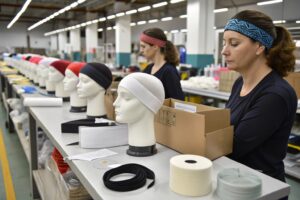Sourcing sweatbands that actually stay in place during intense workouts is a serious challenge for many athletic retailers. With the rise of high-intensity training and yoga-based sportswear, the demand for non-slip grip sweatbands has surged. But not all factories can produce the consistent quality and performance global retailers need. So how do you find the right partner in this fast-moving niche?
If you're an athletic wear retailer or online sports gear brand, sourcing non-slip sweatbands from a trusted manufacturer in China can solve both your supply and product development headaches.
In this article, I’ll break down the exact things you should look for—whether you're a buyer sourcing bulk orders for your activewear chain, a startup launching a gym accessory line, or a buyer for a big-box retail store.
What Materials Ensure a Secure Non-Slip Fit?
Different fibers and materials affect how sweatbands perform under real workout pressure. If you’ve ever tried a cheap sweatband that kept sliding off, you know the importance of material choice.
Non-slip grip sweatbands typically combine silicone strips, spandex, elastic cotton, and sweat-absorbing blends like polyester or bamboo fiber.

Why Is Silicone Gripping Essential?
Sweatbands with internal silicone lines create a friction surface that clings to the hairline without irritating the skin. This is particularly crucial for high-intensity activities like spin class, CrossFit, and tennis. Silicone grips should be medical-grade, BPA-free, and machine washable. Brands like Junk Brands have perfected this combo for American sports enthusiasts.
How Does Moisture-Wicking Fabric Add Value?
Sweat-wicking materials like Coolmax and bamboo rayon draw moisture away from the skin. Not only does this keep the forehead dry, but it prevents slipping. Retailers targeting yoga studios or wellness influencers can pair function with eco-conscious performance fabrics for added appeal.
What Customization Options Matter Most to Buyers?
In the sportswear niche, customization isn't just about looks—it’s about branding, fit, and market appeal. Buyers want to know they can offer sweatbands that reflect their brand identity while still delivering top-tier performance.
The best factories allow buyers to customize grip placement, band width, stitching type, and even odor-resistant finishes.

Can I Customize Grip Positioning and Elastic Width?
Yes. Brands serving different markets (e.g. men’s gym wear vs. women’s Pilates) often need variations in elastic width and grip strip layout. For example, Lululemon’s thin silicone sweatbands cater to runners, while thicker bands serve powerlifters better.
What About Logo Techniques and Packaging?
Popular customization methods include sublimation printing, woven labels, silicone 3D logos, and embroidery. For packaging, many retailers choose recycled paper wraps or zip poly bags with barcode integration. See Packlane for packaging inspiration tailored to activewear.
How Can I Ensure Quality and Performance at Scale?
Mass production of sweatbands with consistent non-slip performance requires strong quality control systems. You don’t want a batch where half the bands lose grip after three washes.
Professional factories conduct performance testing at each step—from elastic pull to silicone bonding.

How Are Non-Slip Features Tested?
Grip tests involve machine-stretching silicone strips over artificial scalp surfaces while sweating simulation fluid is applied. Moisture-wicking is tested using fabric penetration methods like those detailed by AATCC standards.
How Can I Verify QC Before Shipping?
Ask your supplier for QC photos, elastic tension reports, and third-party inspection certificates. At HairAcc, we welcome pre-shipment inspections through firms like SGS or Intertek, giving you full visibility into your order's condition before it leaves our warehouse.
What Shipping & Compliance Factors Should I Consider?
For many of our athletic brand clients, the final mile is just as critical as the first stitch. Sweatbands must ship in a way that prevents damage to the grip, avoids bending, and meets retail compliance standards in destination countries.
Smart shipping and documentation keep customs delays and retailer chargebacks away.

Do Sweatbands Require Special Packaging for Shipping?
Yes. Since silicone strips can warp under heavy pressure, we use plastic inserts or head molds inside cartons for large orders. This keeps the bands intact when shipping long distances via air or sea. Review FedEx packaging tips for more inspiration.
What Compliance Documents Are Required for the US/EU?
For Europe and the US, you’ll need documentation showing material compliance (e.g. REACH, OEKO-TEX). For retail chains, barcode labeling (like GS1 UPC codes) is essential. At HairAcc, our export team prepares HS codes, invoice declarations, and customs forms for DDP delivery—so you don’t deal with delays.
Conclusion
If you're looking to tap into the booming sports accessories market, sourcing non-slip grip sweatbands from an experienced Chinese factory like HairAcc can be your smartest move. With our full support for customization, quality testing, and logistics, we’ve helped athletic brands, sportswear stores, and e-commerce sellers build reliable private-label lines. Don’t let poorly made sweatbands ruin your brand reputation—partner with a team that understands global retail standards from design to delivery.









